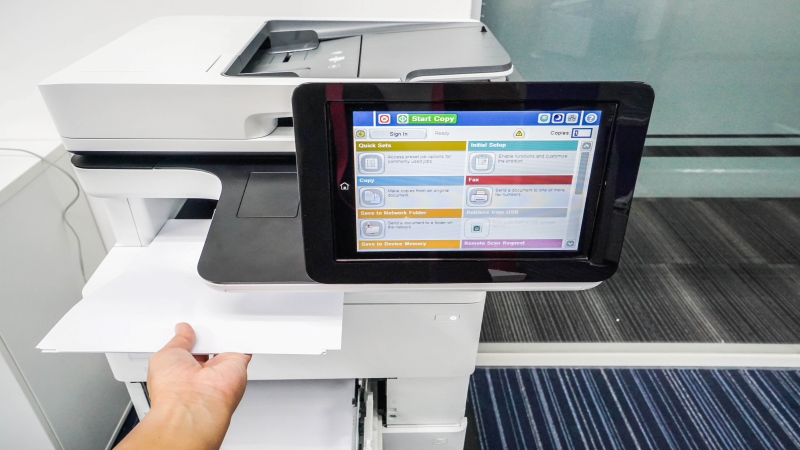A multifunction printer is an excellent piece of office equipment for every company, regardless of size and industry. It has many productivity and budget-related benefits and can streamline the workflow in physical and hybrid workplaces.
However, without proper configuration, multifunction printers can do a lot of damage. Find out why it’s a top business cybersecurity threat and what you can do to change that.
Is a Multifunction Printer a Security Risk?
Multifunction printers are subject to more security risks than traditional printers. Some of the vulnerabilities include.
- Unauthorized access to reroute or read print data
- Stealing saved files
- Manipulating print jobs to change the information
- Disclosing proprietary information
- Using printers as network attack points
- Intercepting print commands in cloud-based printing
But like every other device and machine with an internet connection, companies can mitigate the danger by using various security protocols and systems.
Steps to Take to Increase Security in a Multifunction Printer
There are at least five ways network administrators and office managers can ensure a multifunction printer — or an entire fleet — has enough protection to allow safe operation.
Limit Access
Just because people might need to use the office multifunction printer doesn’t mean everyone should have unrestricted access. Multifunction printers need professional configurations to operate smoothly, prevent data loss, and remain secure.
Limiting access to select employees or a network administrator is one of the best ways to keep a printer safe. Actions like adding account names, changing firewall settings, and changing passwords shouldn’t be available to everyone in the office.
If you’re working with a managed print service provider, it’s probably best to outsource the printer management and handle these things remotely.
Use Authentication
Authentication should be a top priority when operating a multifunction printer. People who want to perform a print job should enter either a PIN, account name, and password or use a card to prove their identity.
This security protocol helps prevent data loss and leaks from unclaimed print jobs. In addition, accessing the printer remotely will also require authentication. Therefore, hackers will have a harder time snooping around in your company’s files.
Perform Firmware Updates
Like other office equipment, mobile devices, and workstations, multifunction printers get firmware updates. A firmware update can include various improvements to productivity, resource consumption, printing speed, adding new features, etc.
But firmware can contain security vulnerabilities that third parties may exploit to access data stored on the printer. Keeping the firmware updated to the latest version makes printers less of a security risk.
Companies without on-site technicians can reach out to the manufacturer for support. Alternatively, businesses can work with managed print service providers. The latter works even better thanks to the 24/7 support and active monitoring of printing machines. Service providers can quickly identify old firmware and perform the necessary updates.
Add Malware Protection
Multifunction printers are more advanced than traditional office equipment. They can accept remote commands, print in advance, offer document previews, connect to the internet, etc. But advanced technology comes with a drawback. It makes printer security a top priority.
An office multifunction printer becomes part of the office ecosystem. It becomes another connected device on the network. That means it communicates with mobile devices, workstations, software applications, and so on
Due to having low security by default, modern printers can act as gateways for hackers to break into a network and corrupt or steal data from connected devices. Sending a corrupted file with malware to the printer can compromise the machine. The same applies to downloading files directly to the printer from unsecured websites.
Malware protection is crucial for improving printer security and office infrastructure security as a whole.
A managed print service provider can access various software solutions to scan and prevent malware from infecting printers. Active monitoring also helps third-party network admins to put the printer out of commission until they can resolve the problem.
Companies that don’t already have multifunction printers can be more selective with their buying process. Instead of opting for a low-end multifunction printer, they can work with a reputable vendor and service provider to install printers with built-in security protocols for even better data protection.
Encrypt Scans
Scanning is one of the leading causes of data loss and theft among multifunction printers. If the scan function isn’t configured correctly, scanned documents can end up in the wrong hands.
Adding encryption and digital signatures to PDF files protects important documents from reaching the wrong destination. Furthermore, a network admin can create additional rules and permissions for user authentication and ensure no unauthorized third parties can read the information in the scanned files.
Work With an Experienced Managed Service Provider
The managed services industry is paving the way for a safer, cost-effective, and more productive office environment. Modern office equipment has come a long way and can perform more tasks than ever before, faster and better. But once equipment like a multifunction printer becomes part of the company’s network, it can become a potential security risk.
Printers need the same level of security scrutiny as workstations, routers, WiFi networks, mobile devices, etc. A managed service provider specializing in printers and IT can offer third-party monitoring, consultation, configuration, and rapid interventions.
That way, the printer always gets the latest security updates, controls user access, and stays protected against malware and hacks. Managed service packages are often customizable, so each client can create a personalized plan to address their unique needs.
Get in touch with KDI and protect your multifunction printers in the Philadelphia, Eastern Pennsylvania, New Jersey, and Delaware area today.

